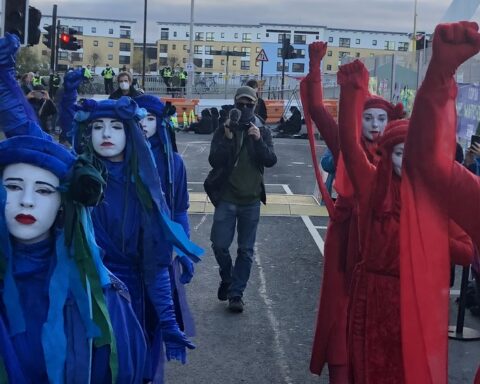Air pollution is a multifaceted problem – representing the world’s leading environmental risk to health and costing the globe an estimated $8.1 trillion in 2019 , 6.1 percent of global gross domestic product (GDP).
Air pollution is also deadly, causing or contributing to heart attacks, strokes, lung cancer, and respiratory diseases and killing an estimated seven million people every year – with about 95 percent of these deaths occurring in low- and middle- income countries. COVID-19 is only making matters worse, with research finding links between air pollution and COVID-19 hospitalizations and deaths.
More than 90 percent of the world’s population lives in areas where pollution levels exceed World Health Organization guidelines. Exposure to PM2.5, fine inhalable aerosol particles that are harmful to human health, is five to ten times higher in South Asia, the Middle East, and Africa than in North America.
As such, tackling air pollution represents an obvious component of the World Bank’s mission to eradicate poverty and promote shared prosperity. What is less obvious, however, is what, exactly, can be done to address this problem.
In recognition of the second annual United Nations International Day of Clean Air for blue skies, we are calling on policymakers and development partners to answer this call by considering three priorities that can help clear the air and save lives.
1. Improve availability of data on air quality
The first step toward reducing air pollution is identifying where the problems are, their causes, and how bad the problems actually are. Ground-level monitors represent a key instrument in this process. Unfortunately access to these differs greatly across the world. High-income countries, for example, have one monitor for every 370,000 people while low-income countries have just one for every 65 million!
In response to this challenge, the World Bank supports the expansion of ground-level monitoring in underserved regions. Recent research shows that satellite technology cannot replace monitors on the ground in low- and middle-income countries. Recognizing this, the World Bank is supporting the development of environmental information systems which, in places like Peru, for example, includes the expansion of the air quality monitoring network to six new cities and new systems to disseminate information on environmental quality to the public.
2. Prioritize key sources of air pollution, notably coal-fired power plants and diesel-fueled vehicles
Building on the need to collect data, we also need to ensure that this data is utilized to underpin actions that can be taken to prioritize key sources of air pollution. Recent World Bank research on the health effects of different sources and chemical compositions of air pollution concluded that emissions from coal-fired power plants and diesel vehicles are particularly toxic to humans and are most consistently associated with heart attacks. Many of these same leading air pollutants also contribute to climate change and are emitted from the same sources – meaning our efforts to manage air quality can have the knock-on effect of also contributing to our climate goals. An integrated approach to both the air pollution and climate crises can produce win-win solutions for human health.
An example of the work have done in this direction can be found in the Hebei Province of China, where the World Bank has been supporting officials to target diesel and coal emissions, as well as industrial emissions, in an effort to reduce concentrations of PM2.5. Hebei’s annual average PM2.5 concentration level decreased more than 40 percent over a six-year period. Deploying cleaner stoves in two of the region’s cities alone contributed to a reduction of annual carbon dioxide emissions equivalent to taking 1.2 million passenger vehicles off the road every year.
3. Address air pollution across boundaries.
Air pollution does not respect jurisdictional boundaries, making the need for regional cooperation on this issue essential. Although air pollution has typically been considered a problem of cities and urban areas, we now know from our work in China and India that pollutants outside of city lines can also contribute to poor urban air quality. For example, the use of nitrogen-based fertilizers, the burning of solid wastes, and the existence of crop residues in agriculture can be sources of air pollution. In addition, naturally occurring dust, which can be increased through land, water, and farming practices, also travels great distances across countries through sandstorms and wind and has been shown to pose similar health threats to other types of particulate pollution. By taking a unified approach, policymakers can prioritize actions that will benefit people in their own countries, as well as in neighboring ones.
Looking ahead
As countries continue to grapple with the health, social, and economic costs of air pollution, they would be wise to take a broad and inclusive approach to these challenges – focusing on the abovementioned areas, as well as other priority sectors and actions. For example, over the last five decades the World Bank has provided nearly $4.4 billion in financing to the Mexico City Metropolitan Area for projects spanning air quality management, transportation, energy, and other sectors – contributing to decreases in particulate matter pollution by more than 70% during this period.
Exacerbating these challenges are the ongoing COVID-19 pandemic and the ever-present reminders of climate change. However, by taking steps to both identify the problems of air pollution as well as solutions to these problems, countries can go a long way toward overcoming all of these collective challenges – which offers the very tangible benefit of improving the health of their people, the strength of their economies, and the overall condition of planet Earth.






